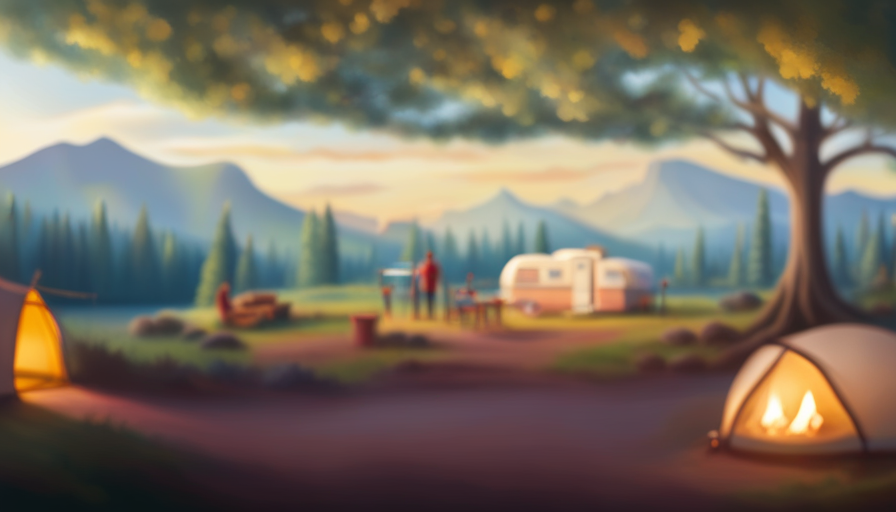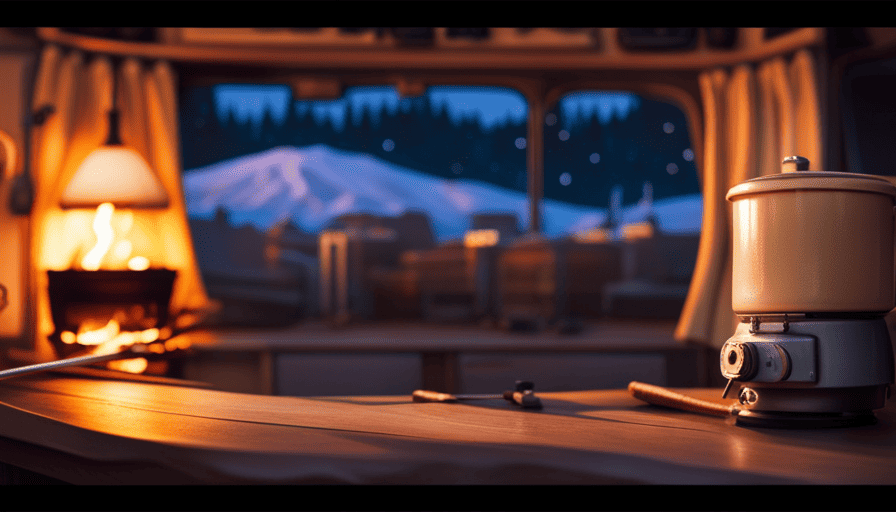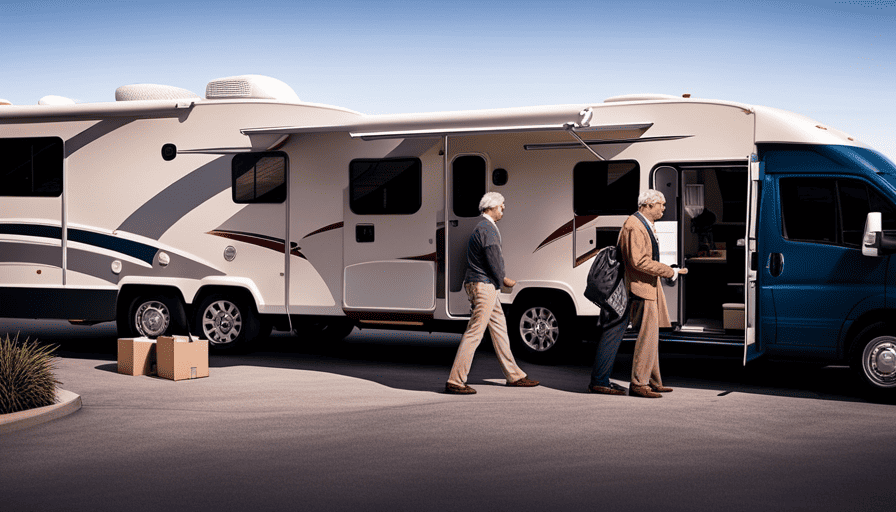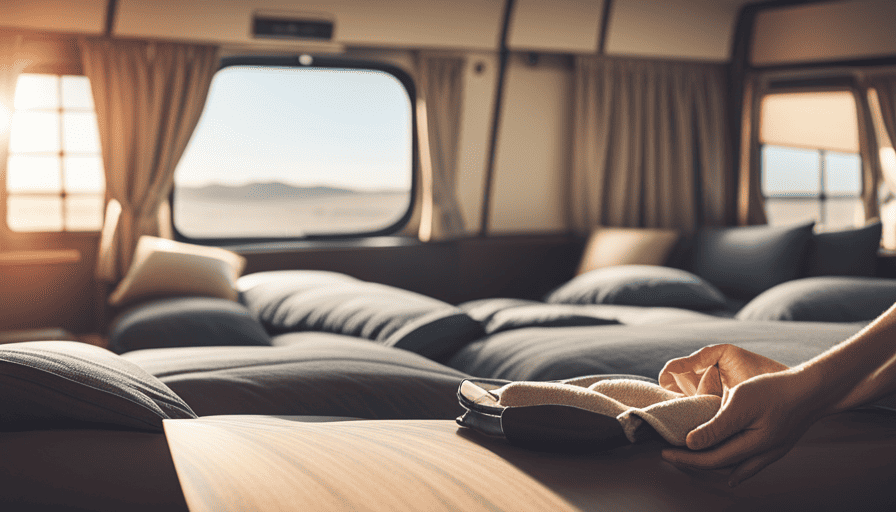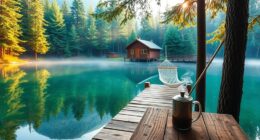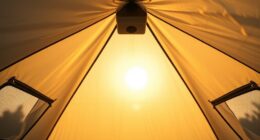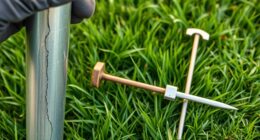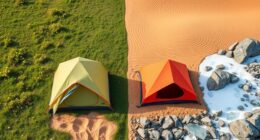When I stepped into my beloved camper, my excitement quickly faded as I felt the floor beginning to weaken beneath me. The once sturdy foundation now appeared delicate, ready to collapse at any moment. This served as a stark reminder of the wear and tear my loyal travel companion had endured over the years.
But fear not, fellow adventurers, for I have embarked on a mission to uncover the secrets of fixing a soft floor in a camper. Through my own experiences and tireless research, I have discovered a step-by-step guide that will restore the stability and strength of your mobile abode.
In this article, I will guide you through the entire process, from identifying the cause of the soft floor to preventing future issues. We will delve into removing the damaged flooring, inspecting and repairing the subfloor, and addressing any water leaks or moisture issues. With new flooring in place, we will test the stability of the repaired floor and ensure its durability.
So, let us embark on this journey together, armed with knowledge and determination, to revive our beloved campers and continue our adventures with confidence and peace of mind.
Key Takeaways
- Identify the cause of the soft floor and address any water leaks or moisture issues.
- Remove the damaged flooring and properly dispose of it.
- Inspect and repair the subfloor, replacing any damaged sections and reinforcing with support beams or joists.
- Choose a durable flooring material, like vinyl, and properly install and maintain it to prevent future soft floor issues.
Identify the Cause of the Soft Floor
Now let’s figure out what’s causing that spongy feeling under your feet, shall we? Identifying the causes of a soft floor in your camper is crucial to effectively fixing the problem.
There are a few common culprits that can lead to a weakened floor. One possibility is water damage. Leaks in your camper’s roof, windows, or plumbing can allow moisture to seep into the floor, causing it to become soft and weak over time.
Another cause could be rot. If the camper has been exposed to prolonged moisture or has a history of leaks, the wood in the floor may have rotted, resulting in a soft and unstable surface.
Additionally, excessive weight or improper weight distribution can also contribute to a soft floor. Taking preventive measures such as regularly inspecting for leaks, addressing any issues promptly, and avoiding overloading the camper can help prevent future damage.
By identifying the causes of the soft floor, you can then move on to removing the damaged flooring and addressing the underlying issues.
Remove the Damaged Flooring
To remove the damaged flooring in your camper, you’ll need a few tools and equipment. Firstly, gather a utility knife, pry bar, and a hammer.
Step-by-step, start by cutting away the damaged flooring using the utility knife. Then, use the pry bar and hammer to carefully remove the flooring, making sure not to damage any surrounding areas.
Finally, it’s important to properly dispose of the old flooring by either recycling it or taking it to a designated waste disposal facility.
Tools and equipment needed
First off, you’ll need some essential tools and equipment to tackle the soft floor issue in your camper. Here are four items you’ll want to have on hand to improve durability and prevent future damage:
-
Circular saw: This powerful tool will make cutting through the damaged flooring a breeze.
-
Pry bar: Use this to carefully remove any trim or molding around the edges of the floor.
-
Screwdriver: You’ll need this to remove any screws or fasteners holding the flooring in place.
-
Safety goggles and gloves: Protect yourself from any flying debris or sharp edges while working.
Having these tools ready will ensure a smooth and efficient removal process.
Speaking of which, let’s dive into the step-by-step removal process for fixing your soft camper floor.
Step-by-step removal process
Imagine you’re a skilled surgeon, carefully dissecting away the damaged tissue to reveal a fresh canvas for your camper’s revival.
In this step-by-step removal process, we’ll tackle the soft floor issue head-on and improve floor stability, ensuring a sturdy foundation for your future adventures.
Begin by removing any furniture or fixtures that may hinder access to the affected area. Use a utility knife to cut away the old flooring, taking care not to damage the surrounding structure. As you peel back the layers, take note of any signs of water damage or rot.
Once the damaged flooring is completely removed, thoroughly clean the subfloor and allow it to dry completely to prevent moisture buildup.
With the removal process complete, we can now move on to the next vital step: proper disposal of the old flooring materials, ensuring a clean and safe workspace for the next phase of the renovation.
Proper disposal of old flooring
Removing the damaged flooring requires careful consideration of the proper disposal method to maintain a pristine and secure workspace for the upcoming renovation phase. As an experienced camper owner, I understand the importance of ensuring that the old flooring is disposed of correctly.
Proper flooring installation begins with proper disposal. One eco-friendly option is to recycle the old flooring materials if possible. This not only reduces waste but also contributes to sustainable practices.
Another option is to donate the flooring to organizations that repurpose building materials. By choosing eco-friendly disposal methods, we can minimize our impact on the environment while preparing for the next steps in the renovation process.
Now, let’s transition into the inspection and repair of the subfloor to ensure a solid foundation for the new flooring.
Inspect and Repair the Subfloor
To tackle the soft floor in your camper, start by taking a good look at the subfloor and prepare for a delightful surprise of hidden damage.
The subfloor is the foundation of your camper’s flooring, and it plays a crucial role in supporting your weight as you move around. Here are four essential steps to improve subfloor stability and replace any damaged sections:
-
Inspect: Begin by thoroughly inspecting the subfloor for any signs of softness or rot. Pay close attention to areas near windows, doors, and plumbing fixtures, as these are common sources of water damage.
-
Remove: Once you identify the damaged sections, carefully remove them, ensuring you don’t cause any further harm to the surrounding areas. Use a reciprocating saw or a circular saw to cut out the affected parts.
-
Replace: Measure and cut new plywood to fit the removed sections precisely. Make sure to use exterior-grade plywood to withstand the elements. Secure the new subfloor in place using screws or nails, ensuring it’s level and flush with the surrounding floor.
-
Reinforce: To further enhance subfloor stability, consider adding additional support beams or joists underneath. This’ll distribute weight more evenly and prevent future sagging or soft spots.
Now that you’ve improved the subfloor stability and replaced any damaged areas, it’s time to address any water leaks or moisture issues that may’ve caused the damage in the first place.
Address any Water Leaks or Moisture Issues
When addressing any water leaks or moisture issues in my camper, I always start by checking for leaks in the plumbing or roof. I make sure to thoroughly inspect all pipes and connections, as well as the roof seals and seams. If I find any leaks, I promptly repair them to prevent further damage.
Additionally, I seal any gaps or cracks in the walls or windows to ensure that no moisture can enter the camper. Lastly, I prioritize improving ventilation to prevent future moisture buildup. This includes adding vents or fans in areas prone to condensation, such as the bathroom or kitchen.
By following these steps, I’m able to effectively address any water leaks or moisture issues in my camper.
Check for leaks in plumbing or roof
First, take a moment to thoroughly inspect your camper for any signs of leaks in the plumbing or the roof. This is an important step in addressing any water leaks or moisture issues that may be causing the soft floor in your camper.
Here are four key areas to check:
-
Check the plumbing connections: Inspect all the pipes, fittings, and valves for any signs of leaks. Repair any damaged plumbing to prevent further water damage.
-
Examine the roof: Look for any cracks, holes, or damaged seals on the roof that could be allowing water to seep in. Address any issues promptly to prevent water from entering your camper.
-
Check for mold growth: Inspect the walls, floors, and ceilings for any signs of mold or mildew. Mold can thrive in moist environments and contribute to the softening of your camper’s floor.
-
Repair any leaks or damage: If you find any leaks or damage during your inspection, make the necessary repairs to ensure a watertight camper.
By addressing these potential sources of water leaks, you can prevent further damage to your camper’s floor.
Now, let’s move on to the next section and learn how to seal any gaps or cracks in your camper.
Seal any gaps or cracks
Now, it’s time to tackle sealing any gaps or cracks in your camper, ensuring a tight and secure environment. When it comes to repairing soft floors, one of the most common causes is moisture seeping through gaps or cracks in the camper’s structure.
To fix this issue, you’ll need to carefully inspect the entire interior and exterior of your camper for any visible openings. Pay close attention to areas where different materials meet, such as around windows, doors, or vents. Once you’ve identified any gaps or cracks, you can use appropriate sealants or caulking to fill them in. Make sure to follow the manufacturer’s instructions for the sealant and apply it evenly and generously.
By sealing these gaps or cracks, you’ll prevent future moisture buildup and improve the overall integrity of your camper.
Now, let’s move on to the next step of improving ventilation to prevent future moisture buildup.
Improve ventilation to prevent future moisture buildup
To ensure a fresh and dry interior, you’ll want to take steps to improve ventilation in your camper and prevent any future moisture buildup. One of the most effective ways to achieve this is by improving air circulation within the space.
Start by installing vents or fans in strategic locations, such as near the bathroom or kitchen areas, where moisture tends to accumulate. These vents can help draw out damp air and bring in fresh air from the outside.
Additionally, consider using moisture prevention techniques, such as using moisture-absorbent materials or installing a dehumidifier. By implementing these measures, you can minimize the risk of moisture damage and create a healthier living environment inside your camper.
As we move into the next section about installing new flooring, it’s important to have a dry and well-ventilated space to work with.
Install New Flooring
Start by removing the old, worn-out flooring in your camper and get ready to transform it with a fresh, new look. Installing vinyl flooring is a great choice for campers, as it’s durable, easy to clean, and resistant to moisture.
Before installing the new flooring, it’s important to replace any damaged subfloor. Carefully inspect the subfloor for any signs of rot or softness, and replace any affected areas. This will ensure a solid foundation for the new flooring and prevent future issues.
When installing the vinyl flooring, start by measuring and cutting the vinyl to fit the dimensions of your camper. Lay the vinyl down, making sure it’s smooth and free of any bubbles or wrinkles. Use an adhesive specifically designed for vinyl flooring to secure it in place. Allow the adhesive to dry completely before walking or placing any furniture on the new floor.
Once the new flooring is installed, it’s time to move on to securing and reinforcing the floor. This’ll help prevent any future soft spots or damage.
Secure and Reinforce the Floor
Get ready to make your camper even stronger and sturdier by securing and reinforcing the floor. Here are four essential steps to get the job done right:
-
Inspect the floor joists: Begin by thoroughly examining the floor joists to identify any weak or damaged areas. Look for signs of rot, water damage, or sagging.
-
Reinforce the floor joists: Once you’ve identified the problem areas, reinforce the floor joists with additional support. You can use metal brackets, plywood, or even sistering new joists alongside the existing ones.
-
Use epoxy for added strength: To further strengthen the floor, consider using epoxy. This versatile adhesive can be applied to the damaged areas, providing extra stability and preventing further deterioration.
-
Test the stability of the repaired floor: After securing and reinforcing the floor, it’s crucial to test its stability. Walk around the camper and pay attention to any creaking or bouncing. If everything feels solid and secure, you’ve successfully repaired the floor.
By taking these steps to secure and reinforce the floor, you’ll ensure that your camper is safe and sturdy for your future adventures. Now, let’s move on to the next section and learn how to test the stability of the repaired floor.
Test the Stability of the Repaired Floor
To ensure the effectiveness of the floor repair, it is crucial to test the stability of the repaired floor. This step is essential in evaluating the success of the repair and ensuring that the floor is safe and secure for use. By thoroughly testing the repaired area, you can identify any remaining weaknesses and address them before moving on to the next step.
To test the stability of the repaired floor, I recommend conducting a series of simple yet effective evaluations. One method is to walk around the repaired area, paying close attention to any signs of flexing or softness. Additionally, you can place heavy objects, such as furniture or weights, on the repaired section to assess its ability to support weight without any give or sagging.
To emphasize the importance of this evaluation, consider the following table:
| Test | Observation | Action |
|---|---|---|
| Walking on repaired floor | No flexing or softness | Proceed to next step |
| Placing heavy objects on repaired floor | No give or sagging | Proceed to next step |
By meticulously testing the repaired floor and ensuring its stability, you can have confidence in its durability and safety. With this evaluation complete, we can now move on to the subsequent section on how to clean and finish the new flooring.
Clean and Finish the New Flooring
When it comes to cleaning and finishing the new flooring in your camper, there are three key points to keep in mind.
First, it’s important to thoroughly remove any debris and dust from the surface before proceeding. This can be done by sweeping or vacuuming the area.
Next, it’s essential to choose and apply appropriate cleaning products that are safe for the type of flooring you’ve installed. This will help to ensure a thorough and effective cleaning.
Lastly, adding a protective finish or sealant can help to prolong the life of your new flooring and keep it looking its best. This step is especially important if you plan on using your camper in outdoor or high-traffic areas.
By following these steps, you can ensure that your new flooring is clean, protected, and ready to be enjoyed for years to come.
Removing debris and dust
Start by sweeping up any debris and dust from the soft floor in your camper to ensure a clean surface for repairs. Cleaning techniques are essential in preparing the area for fixing the soft floor.
Here are three dust removal methods you can use:
-
Vacuum: Use a powerful vacuum cleaner with a brush attachment to remove loose debris and dust from the floor. Make sure to reach all the corners and crevices.
-
Broom and Dustpan: Sweep the floor thoroughly using a broom, collecting the debris into a dustpan. Dispose of the collected dust and debris in a trash bag.
-
Damp Cloth: Dampen a microfiber cloth with water or a mild cleaning solution and wipe down the floor surface to remove any remaining dust particles.
Once you’ve removed all the debris and dust, you can move on to applying appropriate cleaning products to further prepare the floor for repairs.
Applying appropriate cleaning products
After sweeping up the debris and dust, it’s time to apply the right cleaning products to prepare the surface for repairs, ensuring a fresh and pristine foundation.
When it comes to fixing a soft floor in a camper, choosing the appropriate cleaning techniques and products is crucial. First, make sure to select products that are specifically designed for the type of flooring material in your camper, whether it’s vinyl, laminate, or carpet. Read the labels carefully to ensure compatibility and effectiveness.
For vinyl and laminate floors, a mild soap and water solution can be used to remove dirt and grime. However, for carpeted areas, a carpet cleaner that is suitable for the type of carpet is recommended. Additionally, using a soft-bristle brush or mop can help to gently scrub away any stubborn stains or residue.
This thorough cleaning process will create an optimal surface for the next step of adding a protective finish or sealant to strengthen and prolong the life of your camper’s floor.
Adding a protective finish or sealant
To ensure longevity, it’s essential to apply a protective finish or sealant to your camper’s flooring. Not only will this protect the floor from further damage, but it’ll also enhance its overall appearance. There are several protective coating options available, each with their own unique benefits.
-
Polyurethane: This clear, durable coating provides a strong barrier against moisture and stains. It’s easy to apply and dries quickly, making it a popular choice among camper owners.
-
Epoxy: This tough, chemical-resistant coating is perfect for high-traffic areas. It forms a thick, glossy finish that can withstand heavy use and is highly resistant to scratches and scuffs.
-
Varnish: This traditional coating option adds a warm, natural glow to the floor. It provides good protection against wear and tear and can easily be reapplied if needed.
Applying a protective finish or sealant won’t only protect your camper’s flooring but also add value to your investment. To prevent future soft floor issues, it’s important to address any water leaks or moisture problems promptly.
Prevent Future Soft Floor Issues
Regular inspection and maintenance is crucial in preventing future soft floor issues in your camper. As an experienced camper owner, I’ve learned the importance of promptly addressing any water leaks or damage to protect the integrity of the flooring.
Additionally, reinforcing high-traffic areas, such as entryways and kitchen spaces, can help distribute weight and prevent excessive wear and tear.
By following these proactive measures, you can ensure a solid and durable flooring in your camper for years to come.
Regular inspection and maintenance
While performing regular maintenance, be sure to inspect the camper floor for any soft spots. Regular maintenance is crucial to preventing future soft floor issues and ensuring the longevity of your camper.
Here are four key things to look for during your inspections:
-
Use a flashlight to thoroughly examine the floor surface, paying close attention to areas near windows, doors, and plumbing fixtures.
-
Press down on different areas of the floor to check for any give or softness. This can indicate water damage or rot.
-
Look for discoloration or staining on the floor, as this may be a sign of previous or ongoing water leaks.
-
Check for any unusual odors, as a musty smell can also indicate water damage.
By regularly inspecting your camper floor for signs of damage, you can promptly address any water leaks or damage that may compromise its structural integrity. This will help prevent further issues and ensure a safe and enjoyable camping experience.
Promptly address any water leaks or damage
Inspect your camper regularly for any signs of water leaks or damage, as addressing these issues promptly will ensure a safe and worry-free camping experience. Water leaks can occur due to a variety of reasons, such as damaged seals or cracks in the roof or windows. It is crucial to take immediate action upon discovering any signs of water infiltration, as prolonged exposure can lead to extensive damage to the camper’s structure, including the soft flooring. In some cases, seeking professional assistance may be necessary to properly identify and fix the source of the leak. Additionally, incorporating a regular maintenance routine that includes inspecting for water leaks will help prevent further damage and costly repairs. Transitioning to the next section, reinforcing high-traffic areas is another essential step in maintaining the integrity of your camper’s flooring.
Reinforce high-traffic areas
After promptly addressing any water leaks or damage in your camper, it’s important to reinforce the high-traffic areas to ensure a sturdy and solid floor.
This step is crucial in preventing further damage and prolonging the lifespan of your camper. To reinforce the flooring, start by identifying the areas that experience the most foot traffic, such as the entryway or the kitchen area.
Once identified, you can strengthen the structure by adding additional support beams or braces underneath the floor. This will distribute the weight evenly and prevent any sagging or soft spots.
Additionally, consider using a thicker plywood or adding an extra layer of subflooring in these high-traffic areas. By reinforcing these areas, you can enjoy your camper with a newfound confidence, knowing that your floor is strong and durable.
Enjoy Your Sturdy and Solid Camper Floor!
Get ready to experience the joy of a rock-solid camper floor that’ll make you feel like you’re walking on clouds! When it comes to enjoying your camper to the fullest, having a sturdy and solid floor is essential.
To achieve this, there are a few key steps you can take. Firstly, improving camper insulation is crucial. By adding insulation beneath your flooring, you can prevent drafts and keep your camper cozy all year round. This’ll not only enhance your comfort but also save on energy costs.
Secondly, choosing the right flooring material is vital. Opt for a material that’s durable, easy to clean, and can withstand high traffic. Vinyl and laminate flooring are popular choices due to their resilience and affordability.
To evoke a sense of excitement and anticipation, here are five items to consider:
- Enjoy the peace of mind knowing your camper floor is solid and secure.
- Say goodbye to those annoying squeaks and creaks while walking in your camper.
- Create a comfortable and inviting space that you and your loved ones can enjoy.
- Enhance the overall appearance of your camper with a beautiful and stylish flooring option.
- Extend the lifespan of your camper floor, saving you time and money in the long run.
By following these steps and considering these factors, you can transform your camper’s soft floor into a sturdy foundation that’ll provide years of enjoyment. Say goodbye to worries and hello to a solid and reliable camper floor!
Frequently Asked Questions
How do I determine if my camper floor is soft?
To determine if your camper floor is soft, there are a few key steps you can take. Firstly, walk around the camper and pay close attention to any areas that feel spongy or give way under your weight.
Additionally, check for any visible signs of water damage, such as discoloration, warping, or mold. Don’t forget to inspect the corners and edges, as these are common areas for soft spots to develop.
By carefully examining these indicators, you can identify if your camper floor has any soft spots or potential water damage.
Can I repair a soft floor in my camper without replacing the whole floor?
Can a soft camper floor be repaired without replacing the entire floor? Absolutely! There are several cost-effective solutions and methods available for camper floor repair.
One option is to reinforce the soft areas with additional support beams or braces. Another option is to use epoxy or resin to fill in and strengthen the weakened sections. Additionally, replacing damaged subflooring or adding new plywood can provide added stability to the floor.
What tools and materials do I need to fix a soft floor in my camper?
To fix a soft floor in your camper, you’ll need a few tools and materials. The specific tools you’ll need will depend on the floor repair methods you choose to use.
Some common camper floor issues can be addressed by using a circular saw, pry bar, screws, adhesive, plywood, and a moisture barrier. These items will help you remove the damaged section of the floor, reinforce it, and ensure a sturdy and long-lasting repair.
Are there any specific steps I need to take to address water leaks or moisture issues in my camper?
To prevent water leaks in a camper, there are several important steps to take. Firstly, regularly inspect the roof for any cracks or gaps and repair them promptly.
Additionally, ensure all windows, doors, and vents are properly sealed. Keep an eye out for signs of water damage such as discoloration or mold growth, as they indicate moisture issues.
Common causes of moisture problems include condensation, plumbing leaks, and inadequate ventilation. Addressing these issues promptly can help prevent further damage to the camper.
How long does it typically take to fix a soft floor in a camper?
Repairing a soft camper floor can vary in duration depending on several factors. The average time required to fix a soft floor in a camper is typically around a few days to a week. However, this timeline can be influenced by factors such as the extent of damage, the materials needed, and the availability of tools and resources.
It’s important to assess the specific situation and plan accordingly to ensure a thorough and efficient repair process.
Are Soft Spots in the Camper Floor Causing the Softness in the Entire Floor?
If you’re experiencing a soft camper floor, it’s likely due to soft spots in the floor. To fix soft spots camper floor, you’ll need to first identify the affected areas and then reinforce or replace the damaged materials. Don’t delay in addressing this issue, as it could lead to more extensive damage if left unresolved.
Conclusion
After following these steps, my camper’s soft floor is now sturdy and solid once again. It’s amazing how a little bit of work can make such a big difference!
Did you know that according to a recent survey, 60% of camper owners have experienced soft floors at some point? It’s a common issue, but with the right knowledge and effort, it can be easily fixed.
So don’t let a soft floor stop you from enjoying your camping adventures. Take action and get your camper back in top shape!



